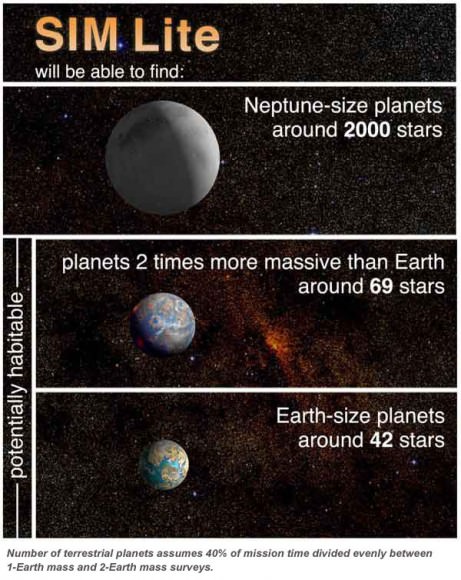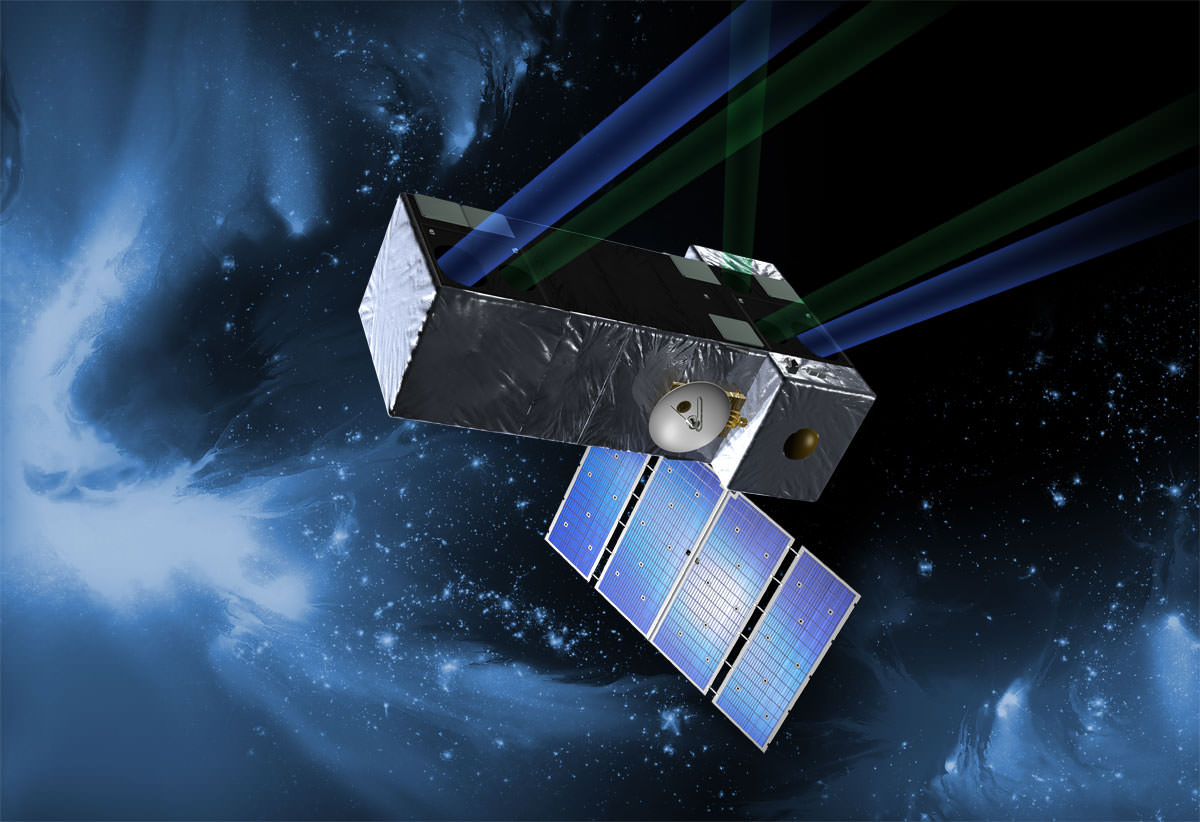[/caption]
Two of the hottest and most engaging topics in space and astronomy these days are 1.) exoplanets – planets orbiting other stars – and 2.) dark matter—that unknown stuff that seemingly makes up a considerable portion of our universe. There’s a spacecraft currently in development that could help answer our questions about whether there really are other Earth-like planets out there, as well as provide clues to the nature of dark matter. The spacecraft is called SIM – the Space Interferometry Mission. “We’ll be looking for other Earths around other stars,” said Stephen Edberg, System Scientist for the mission, “and by making accurate mass measurements of galaxies, we should be able to measure dark matter, as well.”
Listen to the January 20, 2009 “365 Days of Astronomy” Podcast and my interview with Steve Edberg, and/or read more about the SIM Lite mission below!
The concept for this mission has been around for awhile, and the concept has changed over time, with the telescope going through different incarnations. Currently, the mission is being called SIM Lite, as the spacecraft itself has gotten smaller, however the mirrors for the interferometer have gotten bigger.
While interferometry at radio wavelengths has been done for over 50 years, optical interferometry has only matured recently. Optical interferometry combines the light of multiple telescopes to perform as a single, much larger telescope. SIM Lite will have two visible-wavelength stellar interferometer sensors – as well as other advanced detectors, that will work together to create an extremely sensitive telescope, orbiting outside of Earth’s atmosphere.
“These are instruments that can measure positions in the sky to almost unbelievable accuracy,” said Edberg. “Envision Buzz Aldrin standing on the moon. Pretend he’s holding a nickel between thumb and forefinger. SIM can measure the thickness of that nickel as seen by someone standing on the surface of the Earth. That is one micro arc second, a very tiny fraction of the sky.” Watch a video depicting this — (Quicktime needed)
Having the ability to make measurements like that with SIM, it will be possible to infer the presence of planets within about 30 light-years from Earth, and those planets can be as small and low mass as Earth. As of now, the SIM team anticipates studying between 65 and 100 stars over a five year mission, looking for Earth analogs, planets roughly the same mass as Earth orbiting their stars in the habitable zone, where liquid water could exist.
So, for example, SIM Lite would be able to detect a habitable planet around the star 40 Eridani A, 16 light-years away, known to fans of the “Star Trek” television series as the location of Mr. Spock’s home planet, Vulcan. See a movie depicting this possible detection — (QuickTime needed).
SIM will not detect a planet directly, but by detecting the motion it causes in the parent star. “That’s a difficult task, there’s no question,” said Edberg, “but it gets complicated, based on what we see with our own solar system and what we’ve seen in other planetary systems. We know there are other systems out there that have more than one planet. Multiple planets can confound the measurements.”
But SIM should be able to detect the different sized planets orbiting other stars. SIM Lite recently passed a double blind study conducted by four separate teams who confirmed that SIM’s technology will allow the detection of Earth-mass planets among multiple-planet systems, by having the ability to measure the mass of different sized planets, to as low as Earth-mass.
“With a few exceptions all the planets we know about were detected using a method called radial velocity,” said Edberg, “where we look at the periodic motion of the star coming toward us and moving away from us on a regular basis. But when you make measurements like that, when you have no other information, you don’t know the orientation of the planets’ orbit with respect to the star, or the mass of either the star or the planet.”
With the hottest stars, radial velocity can’t be used to look for planets. But SIM Lite will be able to look at stars clear across the diagram from the coolest to the hottest stars.
“So far, we haven’t found any other Earth-sized planets,” said Edberg. (See our article from 1/19/2009 about a planet that could possibly be 1.4 times the mass of Earth.) “So, finding Earth analogs around stars like the sun is really the big goal.”
“It’s a big question mark in the other planets we know about now – I believe we know only about 10% of the masses of extrasolar planets,” said Edberg.
A second planet search program, called the “broad survey,” will probe roughly 2,000 stars in our galaxy to determine the prevalence planets the size of Neptune and larger.

SIM will also be used to measure the sizes of stars, as well as distances of stars, and be able to do so several hundred times more accurately than previously possible. SIM Lite will also measure the motion of nearby galaxies, in most cases, for the first time. These measurements will help provide the first total mass measurements of individual galaxies. All of this will enable scientists to estimate the distribution of dark matter in our own galaxy and the universe.
“Dark matter is known for its gravitational affects,” said Edberg. “It doesn’t seem to interact with normal matter as we know it. To get more clues on it, we want to know where it is.”
SIM will measure on two different scales. One is within the Milky Way Galaxy, making measurements of stars and globular clusters, and making measurements of stars that have been torn out of smaller galaxies that orbit the Milky Way.
“We can do mass model of our galaxy and find out where that mass is, including what has to be a lot of dark matter,” said Edberg. “When we make measurements of how our galaxy rotates, you find that it rotates like a solid. Instead of being Keplerian, where you think of Mercury going around the sun faster than Pluto, from all the way inside the galaxy as close as we can measure to the center, out to beyond the sun’s distance, the Milky Way rotates like it’s a solid body. It’s not a solid body, but that means it must have a density that is constant all the way through and that means there is far more matter than we can see.”
“Another thing we’d like to know is the concentration of dark matter in cluster of galaxies,” Edberg continued. “The Milky Way is part of the Local Group of galaxies, and SIM has the capability to measure stars within the individual galaxies, which in turn can be modeled to tell us where the dark matter is within the Local Group. This is cutting edge. This is one of the big mysteries right now in astrophysics and cosmology.”
Extra solar planets and dark energy may seem like two completely different things for one spacecraft to be looking for, but Edberg said this is an example of how everything is tied together.
“To get planet masses we need to know the masses of the parent stars,” he said. “SIM will make measurements of stars, particularly binary stars, and determine the masses of stars for a wide variety of star types, and be able to estimate the sizes of the planets that are causing the reflex motion. To make the measurements, and because stars with planets are going to be scattered around the sky, we need to have a grid of stars that are the fixed points to give us latitude and longitude, so to speak. If you know exactly where St. Louis and Los Angeles are, then it’s much easier to triangulate where things between them are. We need to do this all around the sky, and to do that we tie that down to the stars, and SIM can do that. These are fundamental questions that we don’t know the answers to, but SIM will help us find the answers.”
So, SIM Lite will be searching from within our neighborhood to the edge of the universe.
What’s the status of this future spacecraft?
“We’re on hold right now,” said Edberg. “We recently passed the double blind test to show that SIM can find Earth-like planets in systems that have multiple planets. SIM is also undergoing a decadal review to make the case that the astronomical science community needs to have a mission like SIM to strengthen the foundations enormously.”
Technical work is being done to prepare to build the actual instruments, but due to budgetary reasons, NASA has not set a launch date. “We think we could be ready to launch by 2015 once we get the go-ahead from NASA,” said Edberg, “and the go ahead depends on the decadal review, and the reports should be out in about a year.”
SIM Lite would provide an entirely new measurement capability in astronomy. Its findings would likely stand firmly on their own, while complimenting the capabilities of our current, as well as other planned future space observatories.
For more information about SIM check out the mission website.


I do agree that SIM Lite mission will be exciting. Yet but when the data is then married with the expected results from NASA’s Wide-field Infrared Survey Explorer “Wise” and the positional accuracy and distance measures of the ESA’s GAIA, to be launched in December 2010 – this picture will be even rosier.
The triumvirate of these three spacecraft will give a very detailed picture of the stellar and planetary environment around the star. This will be equally matched with the distance to the stars examined – and hence the important confirmation of the sizes of these expected newly found planets. Moreover, the results of WISE and GAIA will find the very best targets to examine for Earth-like planets.
Also exciting at the moment is the start of the ground-based projects, especially the Sloan Digital Sky Survey III, due to be completed by 2014 – perfectly timed for the SIM Lite mission.
Within this coming decade we will probably have a realistic view of planetary environments and have the best likelihood of understanding planetary evolution around stars and the possibility of life.
Another likely minor point about SIM Lite, not mentioned in this article, is that we will be able to measure motions and the component properties of many double star and multiple systems – something lacking in our understanding of the nature of these objects.
Very pleased you have given us this subject update, and will look forward to listening to the podcast.
RE: “With a few exceptions all the planets we know about were detected using a method called radial velocity,”
Well, it is not far from true, but you can make a better image about the success of individual methods from these numbers:
All Candidates detected: 335 planets
Radial velocity or astrometry: 309 planets
Transiting planets: 55 planets
Microlensing: 8 planets
Imaging: 11 planets
Timing: 7 planets
The numbers do not add up for the total because some of the planets were detected with multiple methods. Data come from http://exoplanet.eu/catalog.php
No love for Kepler? No one seemed to mention it.
…’bout time we got an optical interferometer in space. TPF or SIM – get something up there for God’ sake.
I agree with Salacious – the next decade or two will be a very exciting time in astronomy, with multiple new technologies to come online with huge potential for revolutionising our understanding of vast tracts of astronomical subject matter.